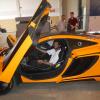
What is engine braking
#1

Posted 13 January 2008 - 15:39
What is engine braking? i do not understand. the only brake i understand is the one you put your foot on? how does this apply to normal cars?
Advertisement
#2

Posted 13 January 2008 - 16:05
Firstly, hard on the brakes and the rear diff locked to stabilise the car in yaw - Honda attempted to do something similar with the front a few years ago, but it was banned. Secondly, the engine management was thought to allow tuning of the brake balance corner-to-corner, in that the zero-throttle fuelling of the engine to could be altered to provide full engine drag or none to the back wheels only, changing the brake balance considerably. The cars "knew" where they were on track via sophisticated GPS systems.
Finally, there were rumours the system could detect the onset of rear-wheel lockup under braking and give power to the rear wheels, although I've never seen this confirmed.
#3

Posted 24 January 2008 - 03:51
In F1 this meant installing a butterfly valve in the exhaust to increase the drag from the engine by compressing air and not exhausting it. The braking from the engine was managed in a way to be very little at first (with the weight transfer to the front wheels) to avoid rear wheel lock-up and then as the weight transfer equalized, rear wheel braking was increased via engine braking.
The alternative to this, variable (or delayed) hydraulic pressure to the rear wheels was one of the key issues in the Ferrari-McLaren spy story.
#4

Posted 24 January 2008 - 07:42
Or is it, perhaps, that the vacuum created by the pistons trying to suck air through a virtually closed inlet port created a resistance to the piston going down the cylinder?
#5

Posted 24 January 2008 - 10:45
Originally posted by Ray Bell
So with the throttle closed, so very little air can enter the inlets, the compression of that tiny amount of air acts as a brake?
Or is it, perhaps, that the vacuum created by the pistons trying to suck air through a virtually closed inlet port created a resistance to the piston going down the cylinder?
Yes Ray a bit of everything including engine/driveline friction but exhaust brakes work better as truck drivers have known before the start of time.
Interesting, when GP 500/Superbikes started to use carbon fibre wheels, the lack of inertia caused bad wheel locking/skitting when the throttle was shut down leading to many systems to get around the problem.
Heres a tip for a traveling man as yourself, do not stay in the hotel in north Yass on the downhill (Hume Hwy), the jake brakes will keep you awake all night
Note, I guess Yass is bypassed by now? Its been a few years.
#6

Posted 25 January 2008 - 04:34
1. North Yass is on the way out to the south.
2. South Yass is on the way in from the north.
3. Possibly you mean the Thunderbird Motel, which used to belong to the Turner family. Chris raced a Clubman out of there.
4. If you stay on the highway you certainly do bypass Yass. The Bypass runs east-west or west-east depending on which way you're travelling, but it still takes you north or south as you desire.
Here's the Yass bypass, with the north-is-south-south-is-north aspect of Yass township (as it used to be on the Hume) evident:

In fact, the Hume is divided road of at least four lanes for all of its length except for a stretch between Gunning and Gundagai, maybe 10kms, and about 80kms in the Tarcutta/Holbrook areas. Even Albury-Wodonga is now bypassed, and that's a real gem!
#7

Posted 25 January 2008 - 17:23
Originally posted by Ray Bell
1. North Yass is on the way out to the south.
2. South Yass is on the way in from the north.
That would make total sense, your whole country being upside down and all. Where I live up north you can't even get to Chicago, it's impossible. You have to drive to the next town over and start from there.
#8

Posted 25 January 2008 - 22:54
Yass is a major town on the main road from Sydney to Melbourne. Or it was... bypassed now as you can see. But it's at a point where the highway generally heads west rather than south-west (or SSW I guess it would be overall), and because of the lay of the land the old highway used to enter the town from the south and emerge from the north as you travelled from Sydney (north) to Melbourne (south).
Actually, I've been thinking of getting back on topic here... I notice when I'm using engine braking, and sometimes I have had to do so very seriously, that there is a point when mechanical stresses really do much more than compression/vacuum forces. You hear the revs rising, the car is gaining speed, then it kind of hits a wall as a critical point is reached.













